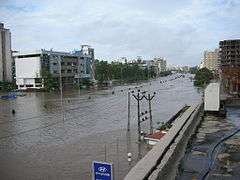2006 Surat flood
The 2006 Surat flood, was a flood during 7-10 August, 2006, which affected Surat and nearby villages. About 80 - 95% areas of Surat were flooded in water.[6][7]
 Gaurav Path flooded in water | |
| Date | 7 August 2006–10 August 2006 |
|---|---|
| Location | Surat |
| Deaths | 120[1]-150[2][3]
|
| Property damage | Rs. 9,500[3] - 21,000[5] crores |
The sudden release of large amount of water in Tapi river from the Ukai dam resulted into the flood. The Government of Gujarat described the floods as a natural disaster while the reports from People's Committee on Gujarat Floods of August 2006 and Surat Citizens' Council Trust's Committee describe this flood as a result of mismanagement.[8][7][3][1]
History of flood in Surat
In 20th century the city of Surat has suffered from some 20 floods. The 1968's flood was one of the major flood with peak water flow of about 15 lacs cusecs (Cubic foot per second), while 1970's flood in Surat had a peak flow about 13.14 lacs cusecs.[9]
The Ukai dam was constructed in 1972 on Tapi river to control the floodwater. The dam was constructed 90 km upstream direction from Surat. After constructing the dam there were no major floods until 1994. The floods of 1978 and 1979 were effectively manged by the dam.
In 1998's flood more than 30% area of Surat was under water due to flood in river Tapi and subsequent release of water from Ukai dam.[1][6]
Causes
Due to heavy rainfall in upstream basin areas the inflow at Ukai dam increased. The water level of dam reservoir was increasing rapidly. On morning of 3rd August the reservoir already crossed the prescribed rule level of 333.60 feet (101.68 m).[7]
The inflow at dam was 85,958 cusecs on 5th august 8.00 am rises to 3,30,216 cusecs on 6th August 8.00 pm. On morning 7th August it became 8,53,679 cusecs.[5] By that time reservoir is already 90% full, very little empty space left to accommodate the floodwater coming from upstream. The inflow was still increasing. The peak inflow during the flood was about 12,00,000 cusecs, but it lasts only for 2 hours.[2]
Operating the gates of dams increased the outflow rapidly. The outflow increased from 1,24,920 (on 6th august, 8.00 am) cusecs to 4,09,004 cusecs on 7th August 8.00 am. Maintaining the same pace of increase the outflow was increased to a peak of 9,07,316 cusecs at 8.00 pm of 9th August. The heavy outflow of about 9,00,000 cusecs during prolonged period of time caused the flood in Surat and other downstream villages. The high tide period of sea during the flood time further reduces the drainage capacity of river and worsen the damages due to flood.[5]
Referances
- "What Surat learned from a preventable flood | Citiscope". citiscope.org. Archived from the original on 8 March 2018. Retrieved 2018-03-08.
- SANDRP. "PEOPLE'S COMMITTEE REPORT" (PDF). South Asia Network on Dams, Rivers and People. Archived (PDF) from the original on 2020-06-16. Retrieved 2020-06-09.
- "2006 Gujarat flood was man-made disaster: PCGF Report". One India. 2007-07-10. Archived from the original on 2020-06-16. Retrieved 2020-06-10.
- Parth, M. N. (2019-02-05). "'We have to learn to live with floods': waterlogged Surat to become latest megacity". The Guardian. ISSN 0261-3077. Archived from the original on 2020-06-16. Retrieved 2020-06-16.
- SANDRP. "SURAT FLOODS: HOW IT WAS AN PREVENTABLE DISASTER" (PDF). South Asia Network on Dams, Rivers and People. Archived (PDF) from the original on 2020-06-16. Retrieved 2020-06-09.
- "State fails to find solution to Surat floods – Times of India". The Times of India. Archived from the original on 8 March 2018. Retrieved 2018-03-08.
- "Citizens' reports indict Gujarat government for Surat floods". www.downtoearth.org.in. Archived from the original on 2020-06-16. Retrieved 2020-06-09.
- "Mismanagement responsible for Surat flood, says report - Indian Express". archive.indianexpress.com. Archived from the original on 2020-06-16. Retrieved 2020-06-09.
- Mavalankar, Dileep; Srivastava, Amit (2008-01-01). "Lessons from Massive Floods of 2006 in Surat City: A framework for Application of MS/OR Techniques to Improve Dam Management to Prevent Flood". Indian Institute of Management Ahmedabad, Research and Publication Department, IIMA Working Papers. Archived from the original on 2020-06-16.